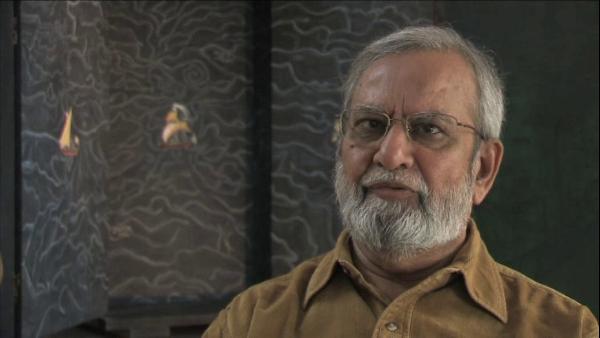NEXT STORY

Pieter Bruegel and other artists
RELATED STORIES

NEXT STORY

Pieter Bruegel and other artists
RELATED STORIES


|
Views | Duration | |
|---|---|---|---|
| 31. The effect of realism on my work and teaching | 63 | 01:03 | |
| 32. My wife and my children | 75 | 04:44 | |
| 33. Vrishchick and Lali Kala | 101 | 04:33 | |
| 34. Geeta Kapur and the Baroda school | 342 | 04:02 | |
| 35. The early '70s, artist’s camps and Place for People | 82 | 06:34 | |
| 36. Developing as artists and people | 58 | 04:46 | |
| 37. Pieter Bruegel and other artists | 42 | 02:50 | |
| 38. The 1975-77 state of emergency | 62 | 05:16 | |
| 39. Kabir | 43 | 06:46 | |
| 40. Benode Bihari Mukherjee and KG Subramanyan | 67 | 04:18 |


Well, there were many issues involved. Well, to elaborate, it was not just architecture and people. It was actually an enquiry within. It was confessional in some sense, you know. It was something where we began to enquire into our own identity, and though we may not see politics in it, we did not see politics in it at that time, although Vivan and Geeta and myself, because they were more politically conscious. It was politics, and in that, I think, as Nilima discovered herself in a different sort of way, as you know, you know, that all her paintings are in a way enquiry into her growth, you know, as a young woman, you know. Her paintings in 'Place for People' actually vouch for that. I mean, if it is for Sudhir to discover the 'Railway Commuters', you know...
Sudhir Patwardhan?
Yah, it is not incidental, you know, it’s part of it, you know, it’s all part of that story. That it was living in Bombay, commuting and watching sort of almost the great humanity travelling from one end of the city to the other, converging in the city of Bombay, but focussed upon one single entity like the commuter train, discovery in a way. We had not discovered such things. Well so, in one sense for me also to make a statement, you know, about self, which I had begun to an extent by writing what I call Gher Jatan, which means going home or returning home, translated into English. They articulated a sort of, both conflict and convergence of worlds that we lived in, the world that was given to us, the world that came to us, the world that we created, and the world we yearn for. In some sense, in physical terms, our own life, life as artists, life as people, and in a sense it was also a coming together, a sort of a meeting of minds.
So, I did those four paintings which were around that period of time. That is, the first one was about ‘Waiting and Wandering’. The second one is called ‘Speaking Street’, the third one was ‘Revolving Routes’, a kind of a circular journey, and the fourth one was ‘City for Sale’, which is about the city of Baroda. I would say even for Bhupen it was a sort of a discovery, not only of his concerns as an artist, but also his sexuality, I would say. You know, it was a time, you know, when churning was in process, a kind of churning, you know, in our minds, in our work, and in a way we also thought of what to paint and what not to paint, how to paint. It was also about language to use, whether we, what is modern. I mean, we didn’t think of post-modern, but maybe perhaps we were thinking of something which was beyond modern. That came in some kind of a, you know, formation. I think the patterns became visible to us, that our minds were, and our works were converging, and hence, ‘Place for People’ is not incidental. It’s part of history, part of a history we all had lived together, and hence in a way, when you came on the scene, you know, you became part of it, you know. It was not something that we did not anticipate, you know. We thought that there were people, you know, in other parts of the world who perhaps went through similar churning and had their own views about both art and the world, and that it was time, you know, for us to make a statement, and hence, I think, there’s nothing grand about it, but that was something very urgent, something very personal, and also collective at the same time.
Gulammohammed Sheikh is an Indian painter, writer and art critic who has been a major figure in the Indian art world for half a century. His artistic career is closely associated with the renowned MS University of Baroda in Gujarat where after gaining his Master's degree, Sheikh went on to teach in the Faculty of Fine Arts, and where he was appointed Professor of Painting in 1982.
Title: Developing as artists and people
Listeners: Timothy Hyman
Timothy Hyman is a graduate of Slade School of Fine Art, London, in which he has also taught. In 1980 and 1982, he was Visiting Professor in Baroda, India. Timothy Hyman has curated many significant art exhibitions and has published articles and monographs on both European and Indian artists.
Duration: 4 minutes, 46 seconds
Date story recorded: December 2008
Date story went live: 18 November 2010